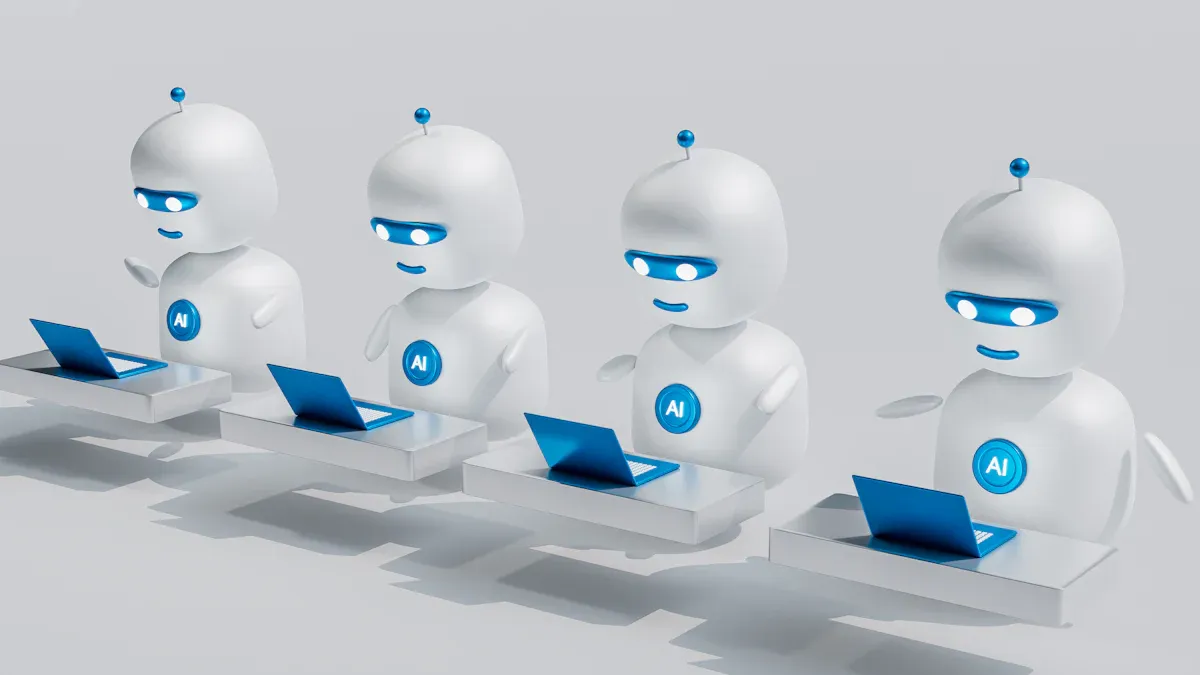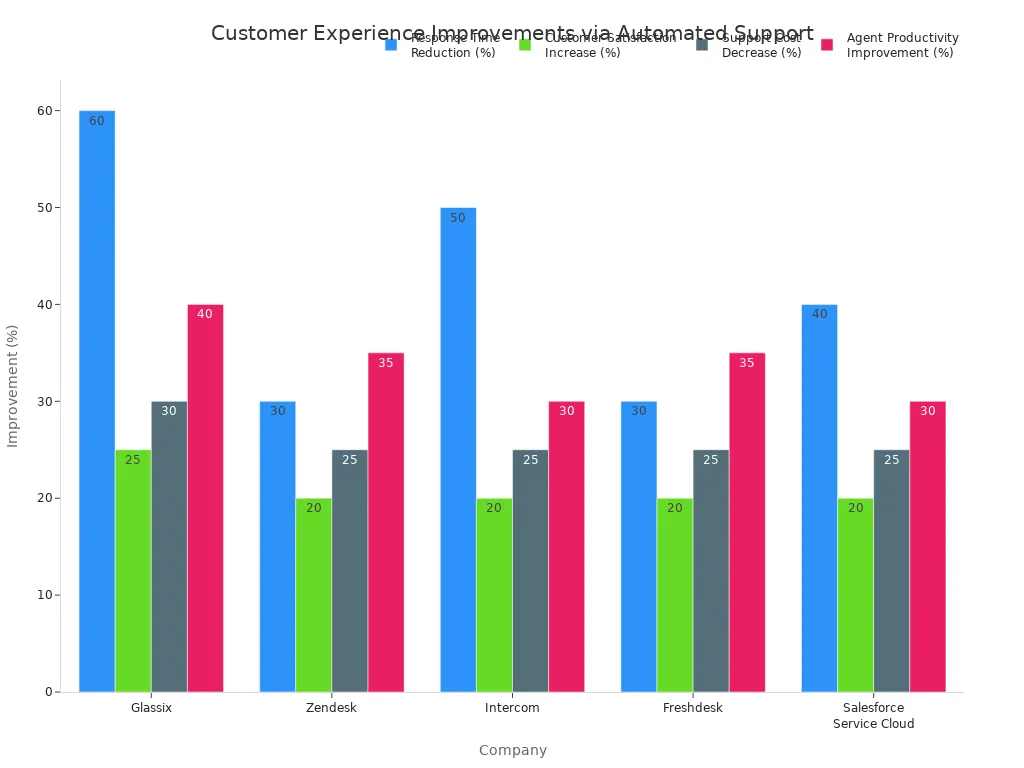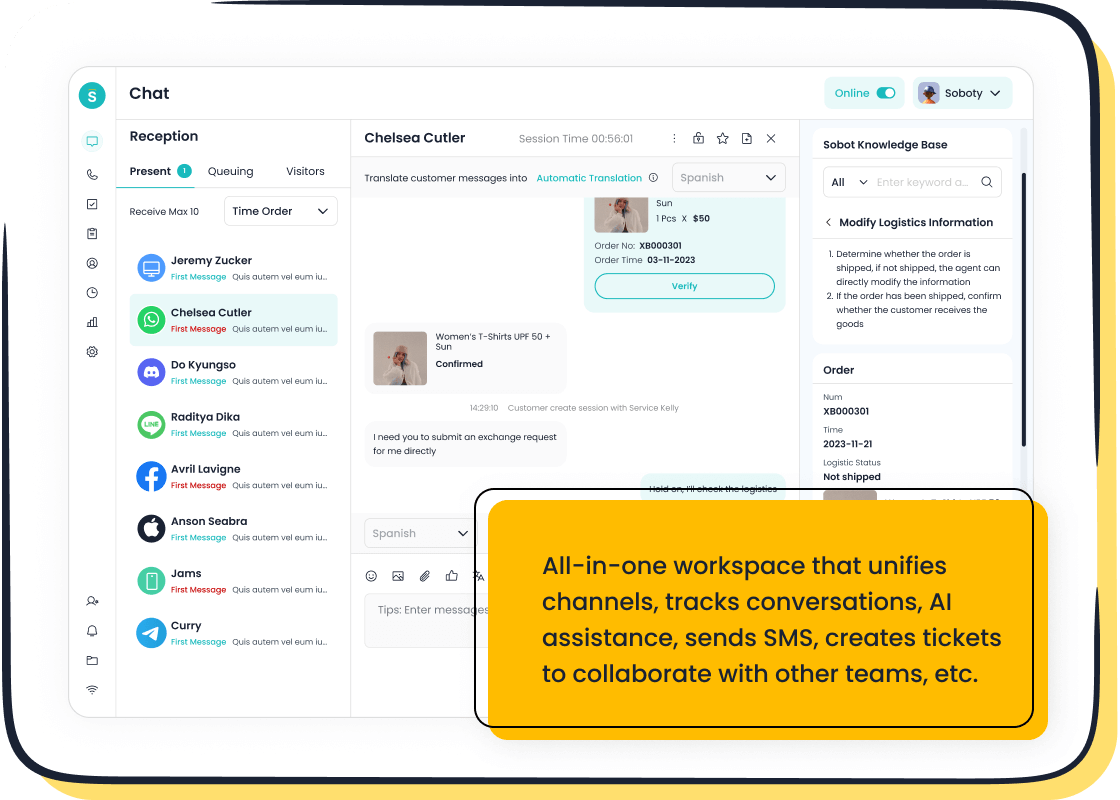Automating Customer Service The Good and The Bad

Automated customer service is a double-edged sword. You can use automation to boost efficiency and provide 24/7 availability for every customer. However, poor automation creates a negative customer experience and can alienate your customer base. Finding the right balance is key to improving customer satisfaction. Your goal is to build an automated good customer service experience solution with smart support automation.
By 2025, AI is projected to handle 95% of all customer interactions.
This shows the growing importance of getting automation right. A platform like Sobot, with its Sobot AI and Sobot call center, helps you enhance each customer interaction and support your team for a better customer experience.
The Good: Benefits of Automating Customer Service

When you implement automation strategically, you unlock powerful benefits that can transform your support operations and strengthen customer relationships. Automation is not just about replacing tasks; it's about refining processes to achieve greater efficiency and a better customer experience. Let's explore the positive impact of a well-designed automated customer service strategy.
Boost Efficiency and Cut Costs
One of the most immediate benefits of customer service automation is a significant boost in operational efficiency. Automation handles repetitive, time-consuming tasks. This frees up your team and streamlines workflows. This improved efficiency translates directly into substantial cost savings.
You can reduce operational expenses by automating routine customer inquiries. AI-powered chatbots, like those offered by Sobot, provide instant answers to frequently asked questions. This reduces the number of tickets that need human attention. The financial impact is significant.
- AI adoption can lead to a 35% cost reduction in customer service operations.
- AI chatbots help lower customer service costs by up to 30%.
- Reports show that 95% of decision-makers at companies using AI see reduced costs.
This cost-effectiveness comes from reducing the time it takes to handle each customer interaction. By automating parts of the process, you can dramatically lower your Average Handle Time (AHT).
| Automation Method | Impact on AHT |
|---|---|
| Speech analytics | Creates smoother experiences, lowering AHT |
| Quality management | Reduces repeat calls, lowering overall AHT |
| Robotic Process Automation (RPA) | Significantly reduces AHT for back-office tasks |
| Knowledge management | Gives agents instant access to information, reducing conversation time |
By implementing the right customer support automation, you create a leaner, more effective support system that delivers impressive cost savings.
Enhance the Customer Experience with 24/7 Support
Today's customers expect immediate answers. They do not want to wait for business hours to resolve an issue or get information. Automation makes 24/7 availability a reality. You can provide round-the-clock support without needing a massive, 24-hour human team. This constant availability is a cornerstone of a modern customer experience.
You can use automation solutions like Sobot's AI-powered Chatbot to offer instant self-service options. A customer can get help at 2 a.m. on a Sunday just as easily as they can during peak business hours. This real-time support meets customer expectations for speed and convenience.
A great example of this is the smart device innovator OPPO. By using Sobot's chatbot for human-machine cooperation, OPPO achieved an incredible 83% chatbot resolution rate and a 94% positive feedback rate. This shows how a smart automated good customer service experience solution enhances the customer journey.

This level of consistency and availability builds trust and shows your customer that you value their time.
Improve Customer Satisfaction and Loyalty
A positive customer experience directly leads to improved customer satisfaction and loyalty. Automation plays a key role here by providing speed, consistency, and accuracy. When customers get fast, correct answers, they are happier.
Many people prefer using self-service for simple questions. Research shows that:
- 74% of customers would choose a chatbot over a human agent for simple questions.
- 62% of people would rather use a chatbot than wait for an agent to respond.
AI-driven support ensures that every customer receives the same high-quality, accurate information. This consistency builds confidence in your brand. When chatbots handle simple queries, they provide automated responses that are quick and precise. This immediate resolution is a powerful driver of customer satisfaction.
Gartner predicts that by 2027, chatbots will become the primary customer service tool for a quarter of organizations. This is because instant answers are crucial for retention. A customer who gets help right away is less likely to become frustrated and look elsewhere. This focus on a seamless customer experience fosters strong customer relationships and encourages repeat business, boosting your customer engagement over the long term.
Empower Agents for High-Value Work
A common misconception is that automation replaces human agents. The reality is that automation empowers them. By using customer service automation tools to handle simple and repetitive queries, you free your agents to focus on what they do best: solving complex problems and building human connections.
When chatbots and other automation handle the basics, your agents can dedicate their time to high-value tasks. These tasks often require empathy, critical thinking, and nuanced decision-making—skills that are uniquely human. Agents can focus on:
- Handling complex or emotionally charged customer issues.
- Making decisions in ambiguous situations.
- Providing personalized consultations and guidance.
- Identifying and escalating emerging trends or problems.
This shift makes their work more engaging and satisfying. Instead of answering the same questions all day, they become true problem-solvers. Tools like Sobot Live Chat are designed for this new reality. They give agents a unified workspace with a full view of the customer's history. This context allows them to provide expert, personalized support for the most challenging customer inquiries. This strategic use of automation not only boosts agent morale but also ensures your most valuable customers receive the highest level of care.

The Bad: Pitfalls of Automated Customer Service
While the benefits of automation are compelling, a rush to implement it without a clear strategy can create more problems than it solves. You risk alienating your customer base and damaging your brand's reputation. Understanding these pitfalls is the first step toward avoiding them and building a system that truly serves your customers. A poor customer experience can undo all potential gains in efficiency.
The Risk of Losing the Human Touch
Technology cannot replace genuine human connection. Your customers are people, and they often need empathy and understanding that automation cannot provide. Forcing every customer interaction through an automated system can feel impersonal and frustrating. This is especially true for complex or sensitive problems. In fact, 75% of consumers prefer to speak with a real person for these types of issues. Some surveys show that number is as high as 93% for all customer interactions.
When you rely too heavily on automation, you may encounter several issues that degrade the customer experience:
- Automated systems struggle to show empathy, which can make a bad situation worse for a frustrated customer.
- Your brand experience can feel inconsistent if a customer has a great interaction on one channel but a terrible one with a chatbot.
- Many customers simply want to connect with a person, and the absence of that option leads to poor service.
Losing the human touch is not just a minor inconvenience. It can actively drive customers away and lead to negative public reviews.
High Costs and Complex Implementation
Many businesses pursue automation with the primary goal of cost savings. However, the initial setup can be surprisingly expensive and complicated. Implementing a comprehensive automation platform is a major project that requires significant investment in both time and money. You need to account for more than just the software license.
Note: For small businesses, the initial investment for AI chatbots and support tools can range from $20,000 to $60,000. This does not include ongoing maintenance, training, and integration costs.
Beyond the financial investment, you will face technical and organizational challenges. A successful automation launch is not a "set it and forget it" task. Common hurdles include:
- Integration difficulties: Making new chatbots work smoothly with your existing CRM, e-commerce, or support systems can be complex.
- Data security: You must ensure your automation solutions handle sensitive customer data safely and comply with privacy regulations.
- Training and maintenance: Your AI-driven support system needs a robust knowledge base and continuous training to remain effective and provide accuracy.
Without proper planning, these high costs and complexities can eliminate any potential cost savings and create major headaches for your team.
Dangers of a Poorly Executed System
A badly designed automated customer service system is often worse than no automation at all. When chatbots or self-service portals fail, they create intense frustration and can make your company look incompetent. This can quickly erode customer trust and loyalty. Several major brands have learned this lesson the hard way.
| Brand | AI Implementation | Customer Backlash/Issue |
|---|---|---|
| McDonald’s | AI-powered drive-thru | The system frequently misunderstood orders, suggesting bizarre items and frustrating customers. |
| AI Overview feature | It provided dangerous and inaccurate answers, like telling users to put glue on pizza or eat rocks. | |
| Duolingo | AI-first strategy | Customers perceived the move as a cost-cutting measure that sacrificed quality and the user experience. |
These examples show that a flawed automated good customer service experience solution can lead to public ridicule and customer churn. A system that provides wrong answers, gets stuck in loops, or misunderstands simple requests reflects poorly on your entire brand. The damage to your reputation can take years to repair.
Limited Understanding of Complex Issues
Current automation technology, including advanced chatbots, has clear limitations. It excels at answering simple, direct questions but struggles with nuance, context, and emotional complexity. When a customer has a unique or multi-layered problem, automated responses often miss the mark, leading to a frustrating and unproductive customer experience.
AI and automation frequently fail when dealing with:
- Complex customer inquiries: If a problem doesn't fit a pre-programmed script, the chatbot is unlikely to resolve it.
- Emotional situations: AI cannot understand a customer's frustration or urgency, often providing generic responses that feel unhelpful.
- Subtle language: Slang, sarcasm, or typos can easily confuse an automated system, leading to incorrect answers.
- Repetitive loops: Customers get stuck explaining their issue over and over, first to a bot and then again to a human agent.
A study on chatbot behavior found that even when chatbots are programmed to express emotions like sadness during a service failure, customers perceive them as less competent. This highlights the gap between artificial responses and genuine human interaction. When your automation cannot solve a problem, it must provide a clear and easy path to a human agent for support.
Finding Balance with an Omnichannel Approach
The key to avoiding the pitfalls of automation is not to abandon it, but to balance it with the human touch. You can achieve this with an omnichannel strategy. This approach unifies all your customer communication channels—like chat, email, and social media—into a single, cohesive system. A platform like Sobot's Omnichannel Solution is designed for this. It integrates automation tools like Chatbots with human support systems like Live Chat and a Ticketing System, creating a seamless customer experience.
Build an Automated Good Customer Service Experience Solution
To succeed, you must build an automated good customer service experience solution from the ground up. This means going beyond basic chatbots. A truly effective system has several core components:
- Intelligent Query Understanding: The system must grasp what a customer means, not just the keywords they use. It should understand context and sentiment.
- Autonomous Problem Resolution: Your automation should be able to solve problems on its own by connecting to other systems and executing multi-step tasks.
- Enterprise Knowledge Integration: The system needs real-time access to your knowledge base to provide answers with consistency and accuracy.
- Omnichannel Orchestration: It must provide a consistent customer experience, allowing a customer to switch from a chatbot to live chat without repeating themselves.
Integrate Automation with Your Human Team
The goal of automation is not replacement but collaboration. You should aim for a hybrid model where automation and human agents work together. This frees your team from repetitive questions and allows them to handle complex issues that require empathy. This integration is where a unified platform shines. For example, Sobot provides a single workspace where agents can see the full context of a customer's interaction with a chatbot before they even join the conversation. This creates a smooth handoff and a better customer experience.
The Hybrid Support Model: This framework ensures AI provides instant, accurate responses to common inquiries and escalates complex issues quickly. Human agents then step in when an issue requires critical thinking, ensuring customers always have access to a real person when needed.
Best Practices for Customer Support Automation
As you implement customer service automation tools, keep these best practices in mind to maintain a high-quality customer experience:
- Define Clear Triggers: Know exactly when a chatbot should hand a conversation over to a human agent. This could be based on keywords, customer sentiment, or repeat questions.
- Preserve Context: Ensure the full chat history and customer data are transferred to the agent. This avoids forcing the customer to repeat their issue.
- Create Feedback Loops: Allow your human agents to provide feedback on the chatbot's performance. This helps the AI learn and improve its accuracy over time.
Always Provide a Clear Path to a Human
Finally, the most important rule of automated customer service is to always give your customer an easy way to reach a person. No matter how advanced your automation becomes, some issues will always require a human touch. Hiding the option to speak with an agent creates frustration and damages customer satisfaction. A simple "Talk to an agent" button within your chatbot interface shows that you value your customer's time and are ready to provide the support they need, in whatever form they need it.
Measuring the Success of Your Automation Strategy
Implementing automation is just the first step. You must measure its impact to know if your strategy is working. Tracking the right metrics helps you understand what is effective and where you need to make improvements. This data shows the true value of your automation investment for both your team and your customer.
Tracking Customer Satisfaction (CSAT)
Customer satisfaction is the ultimate measure of success. You can track CSAT by sending short surveys after an interaction. Ask each customer to rate their experience. This feedback tells you directly how they feel about your automated support. A high CSAT score shows your automation is meeting customer needs effectively. A low score signals that you may need to adjust your processes.
Monitoring First Contact Resolution (FCR)
First Contact Resolution (FCR) measures how often you solve a customer issue in a single interaction. A high FCR rate means your automation and self-service options are efficient. Customers get answers without needing to follow up. This reduces customer effort and improves their experience. Good automation should increase your FCR rate by resolving simple queries instantly.
Analyzing Agent Productivity Metrics
Automation should empower your support agents, not replace them. You can measure this by analyzing agent productivity. Look at metrics like the number of complex tickets an agent resolves. When chatbots handle simple questions, your agents have more time for difficult issues. This focus on high-value work makes your support team more effective and improves overall service quality.
Evaluating Chatbot Containment Rate
Chatbot containment rate shows how many conversations your chatbots resolve without needing a human agent. This is a key indicator of your self-service success. A higher rate means your automation is working well. However, a "good" rate can vary by industry.
For example, e-commerce can aim for a higher rate, while finance and healthcare may have more complex customer inquiries.
| Industry | Good Chatbot Containment Rate |
|---|---|
| General | 70% - 90% |
| E-commerce | Closer to 90% |
| Finance | Around 70% |
| Healthcare | Around 70% |
This metric helps you see if your chatbots are truly helping your customer or just creating a roadblock to human support.
Automation is not good or bad; its success depends entirely on your strategy. The most effective approach is not replacement but augmentation. You should empower your human team with AI tools. This creates a hybrid workforce where technology handles routine tasks, freeing agents to manage complex customer issues. This ensures every customer receives the best possible support. The future of customer service is using technology to enhance the human connection with your customer, not eliminate it. This focus builds a stronger relationship with each customer.
FAQ
How do I start with customer service automation?
You can start small. Identify the most common and repetitive questions your customer support team receives. Use an AI-powered tool like a chatbot to automate the answers. This frees up your team and provides your customer with instant help for simple issues, improving the overall customer experience.
Will automation replace my human customer support agents?
No, automation should empower your agents, not replace them. It handles simple tasks, allowing your team to focus on complex customer problems that require empathy and critical thinking. This approach improves the quality of support for every customer and makes your team's work more valuable.
What is the most important metric to track for automation?
While all metrics are useful, Customer Satisfaction (CSAT) is the most important. It directly measures how your customer feels about their experience. A high CSAT score shows your automation strategy is successfully meeting customer needs and creating a positive impression of your brand.
See Also
Artificial Intelligence Agents Are Transforming Customer Support Experiences
Unlocking Peak Efficiency With Advanced AI Customer Service Software Solutions
Streamlining Operations: The Efficient Mechanics of Call Center Automation
Discovering The Ten Leading Customer Service Software Platforms For 2024
Achieving Excellence: Mastering Live Chat Strategies For Superior Customer Support
